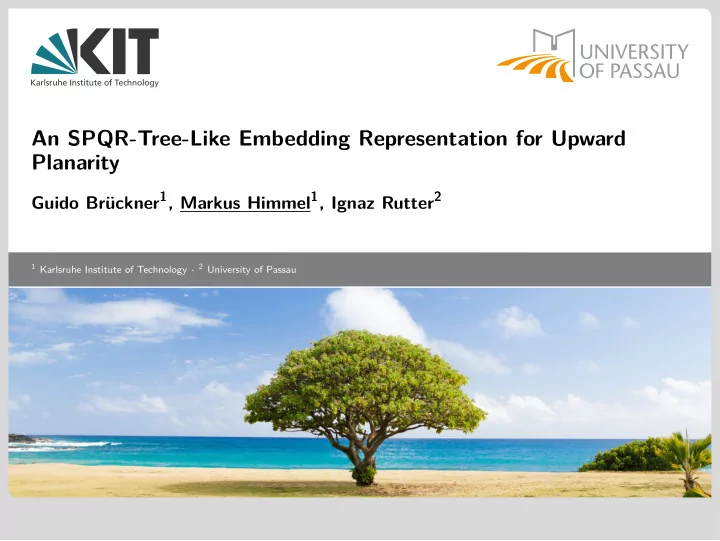

An SPQR-Tree-Like Embedding Representation for Upward Planarity Guido Brückner 1 , Markus Himmel 1 , Ignaz Rutter 2 1 Karlsruhe Institute of Technology · 2 University of Passau 1
SPQR-Trees [Di Battista, Tamassia ’90] P arallel node R igid node Compactly represent all planar embeddings of a biconnected planar graph 2
SPQR-Trees [Di Battista, Tamassia ’90] P arallel node R igid node Compactly represent all planar embeddings of a biconnected planar graph 2
SPQR-Trees [Di Battista, Tamassia ’90] P arallel node R igid node Compactly represent all planar embeddings of a biconnected planar graph Have been used to efficiently solve a range of problems Optimization [e.g. Didimo et al. ’18] , extension [Angelini et al. ’15] , . . . 2
SPQR-Trees [Di Battista, Tamassia ’90] P arallel node R igid node Compactly represent all planar embeddings of a biconnected planar graph Have been used to efficiently solve a range of problems Optimization [e.g. Didimo et al. ’18] , extension [Angelini et al. ’15] , . . . 2
SPQR-Trees [Di Battista, Tamassia ’90] P arallel node R igid node Compactly represent all planar embeddings of a biconnected planar graph Have been used to efficiently solve a range of problems Optimization [e.g. Didimo et al. ’18] , extension [Angelini et al. ’15] , . . . Can we find a similar data structure for the upward planar case? 2
Upward planarity testing Upward planarity testing is NP-hard in general [Garg, Tamassia ’94] 3
Upward planarity testing Upward planarity testing is NP-hard in general [Garg, Tamassia ’94] . . . . . . but linear-time if G is single-source Sufficient to only consider biconnected graphs Basic idea: Decomposition at 2-vertex cuts “Shape” of the rest of the graph ← → suitable marker graph = + 3
Upward planarity testing Upward planarity testing is NP-hard in general [Garg, Tamassia ’94] . . . . . . but linear-time if G is single-source Sufficient to only consider biconnected graphs Basic idea: Decomposition at 2-vertex cuts “Shape” of the rest of the graph ← → suitable marker graph = + Linear-time algorithm by Bertolazzi et al. ’98 based on SPQR-trees Simpler algorithm by Hutton and Lubiw ’96 using general decompositions 3
A decomposition result by Hutton and Lubiw Lemma H 1 H 2 G = + e ⋆ Bijective correspondence between embeddings of G and combinations of embeddings of H 1 and H 2 where Marker graphs determined by a set of rules H 1 or H 2 is single component Fixed edge e ⋆ or its marker are leftmost 4
Decomposition Trees for Upward Planar Embeddings 5
Decomposition Trees for Upward Planar Embeddings 5
Decomposition Trees for Upward Planar Embeddings 5
Decomposition Trees for Upward Planar Embeddings Upward planar embedding ← → upward planar skeleton embeddings Each sequence of decompositions � new characterization of upward planar embeddings 5
Decomposition Trees for Upward Planar Embeddings Upward planar embedding ← → upward planar skeleton embeddings Each sequence of decompositions � new characterization of upward planar embeddings Actually, order is irrelevant 5
Decomposition Trees for Upward Planar Embeddings Important question: Which decomposition tree should we use? SPQR-tree is nice for planar embeddings, but offers too many choices Idea: Modify SPQR-tree to have upward planar skeletons 5
P-Node Splits 6
P-Node Splits Problem: Permuting edges at P-nodes � non-upward-planar skeleton 6
P-Node Splits Problem: Permuting edges at P-nodes � non-upward-planar skeleton Solution: Split P-nodes by marker type Relevant here: , and . 6
P-Node Splits Problem: Permuting edges at P-nodes � non-upward-planar skeleton Solution: Split P-nodes by marker type Relevant here: , and . 6
Arc Contractions 7
Arc Contractions Problem: Flipping operation at R-nodes � non-upward-planar skeleton 7
Arc Contractions Problem: Flipping operation at R-nodes � non-upward-planar skeleton Solution: Contract arcs of the tree that do not give embedding choices Upward planarity test for embedded single-source graphs [Bertolazzi et al. ’98] 7
Arc Contractions Problem: Flipping operation at R-nodes � non-upward-planar skeleton Solution: Contract arcs of the tree that do not give embedding choices Upward planarity test for embedded single-source graphs [Bertolazzi et al. ’98] 7
The UP-Tree SPQR-tree + P-node splits + arc contractions = : UP-tree Theorem For each biconnected single-source DAG G and e ⋆ incident to s there is a decomposition tree T computable in linear time that represents the upward planar embeddings of G in which e ⋆ is leftmost does so using P-nodes and R-nodes Example: Partial upward embedding problem solvable in quadratic time 8
The UP-Tree SPQR-tree + P-node splits + arc contractions = : UP-tree Theorem For each biconnected single-source DAG G and e ⋆ incident to s there is a decomposition tree T computable in linear time that represents the upward planar embeddings of G in which e ⋆ is leftmost does so using P-nodes and R-nodes NB: Dependency on e ⋆ is necessary: 8
Conclusion Theorem For each biconnected single-source DAG G and e ⋆ incident to s there is a decomposition tree T computable in linear time that represents the upward planar embeddings of G in which e ⋆ is leftmost does so using P-nodes and R-nodes Future work: Survey more algorithms that use SPQR-trees and adapt to upward planar case 9
Recommend
More recommend